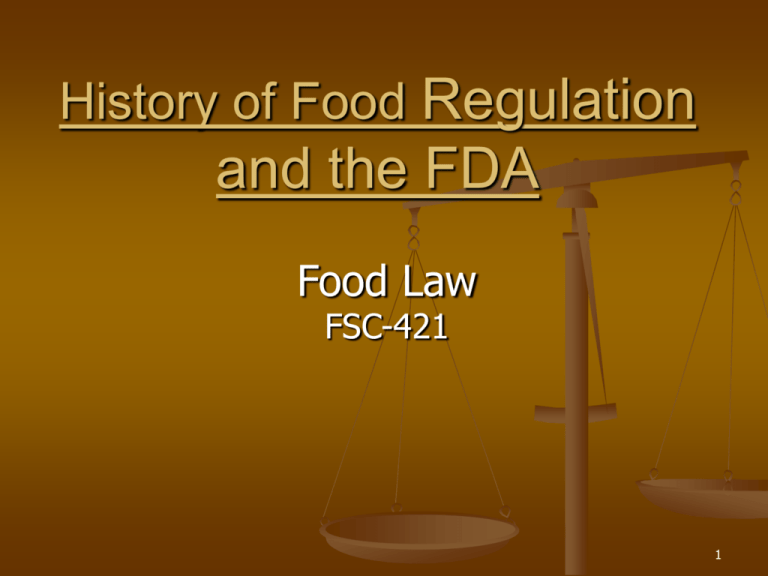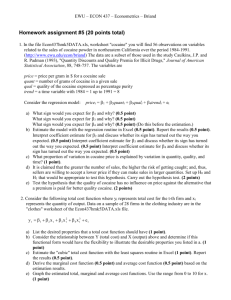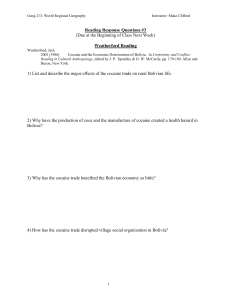History of Food Regulation and the FDA
advertisement

History of Food Regulation and the FDA Food Law FSC-421 1 Ancient Food Regulation 370-285 BC “Enquiry Into Plants” – Theophrastus Treatise on plants as sources of food and medicine Noted that balsum gum was mixed with adulterants for economic reasons 234-149 BC “Treatise On Agriculture” – Cato Noted use of boiled down musk, salt, marble dusk and resin in wines Method to determine if wine watered down 2 Ancient Food Regulation 23-79 AD “Natural History” Pliny the Elder Adulteration of breads with chalk and peppers with juniper berries “so many poisons are used to force wine to suit our taste – and we are surprised that it is not wholesome” “Greatest aid to health is moderation in food” Urged use of kitchen gardens 3 Ancient Food Regulation 131-201 AD “Galen” Roman physician Warned against adulteration of pepper Stellionatus “where anyone has substituted some articles for another; or has put aside goods which he was obligated to deliver, or has spoiled them, he is liable for this offense” 4 Middle Ages England - government decided price of food should be determined by its quality 1266 - Sale of any corrupted wine, meat, fish, bread or water that is not wholesome for man’s body prohibited 1844 - Trade Guilds were major regulatory body Searched and seized unwholesome products 1820 - “Treatise of Adulteration of Food and Culinary Poisons –Frederick Accum 5 Early Food Regulation in the US Simple and local food production and distribution systems Consumer could exert substantial influence over purity or wholesomeness Most foods grown by users, neighbors or from local marketplace where handling and production of produce could be observed 6 Early Food Regulation in the US English experience worked at first Population increased Growing urban communities Reliance upon “food retailers” for surveillance of handling and production Now retailer exerted the influence over suppliers 7 Colonial Food Laws Food Law in US is 300 years old 1646 Massachusetts Bread Law set price for a “loaf of bread” at one penny and decree how much it should weigh Official inspectors could enter homes and seize “light” bread Baking of bread was first commercial food activity in new world 8 Colonial Food Laws Profits increased if short “short weights” and used cheap ingredients like chalk and ground beans Mass, and NY enacted laws to inspect flour for worms 1641 inspection of exported fish, and meat to improve trade relationships 9 General Food Law First State law applying to foods generally instead of a specific product 1785 Act Against Selling Unwholesome Provisions “where some evilly disposed persons from motives of avarice and filthy lucre, have been induced to sell diseased, corrupted, contagious or unwholesome provisions to the great nuisance of public health and peace….. Punished by fine, imprisonment, standing in pillory…” 10 Early Food Laws Iowa 1838 “Act to punish Vendors of Unwholesome Liquors and Provisions Oregon Territory 1848 adopted Iowa Act California 1850 regulated sale of unwholesome provision under Offenses Against Public Morality, Health and Police Law (exercise of 11 State vs. Federal Laws Complications when foods crossed state boundaries Conflicts of Laws Imported product more suspicious than locality produced products (Turf) b/c of lack of ability of scrutinize handling States needed to cooperate to trade 12 Early Federal Regulation 1789 Act for Laying a Duty on Goods, Wares and Merchandize Imported into the US Place duty of specific food items (booze, molasses, sugar, coffee, cheese) to control quantities coming into US (Imported) 1883 Impure Tea Act prevented importation of adulterated teas Provided for inspections for purity and fitness 13 Prohibition Booze only “food product” which has been the subject of a Constitution Amendment 18th Amendment prohibited “manufacture, sale or transportation, importation or exportation of intoxicating liquors Repealed December 18th 1933 Followed by Alcohol Administration Act Protection from adulterated or misbranded articles 14 Oleomargarine Subject of early food legislation b/c of competition between manufacturers and dairy farmers 1879 “Act for Protection of Dairymen and to prevent deception in sales of butter and cheese in District of Columbia Margarine must be stamped “Margarine 15 Inflence of Economics Congress believed food supply was local matter and should be left to States 1880’s American Dress beef, and bacon strong in export market to Europe Europe started to reject American beef b/c of encounters with diseased beef Congress acted to save US beef export market 16 Influence of Economics 1889 Secretary of Agriculture called for national inspection of cattle and condemnation of unfit carcasses Prohibited importation of diseased cattle Congress took positive action to improve the quality of the food supply 17 The “Jungle” Published February 1906 Set in Chicago stockyards Upton Sinclair, novelist concerned with unsanitary conditions in meat packing plants President Theodore Roosevelt read book and called for investigation 4 months later, Meat Inspection Amendment was passed as small part of appropriations bill, not a separate act of Congress 18 Harvey Wiley First “Chief Chemist” of Bureau of Chemistry of USDA Examined foods for evidence of adulteration Formed “Poison Squad” President of AOAC for 25 years Helped to develop sugar industry in US 19 “Pure Foods” (1906) 1906 Senate Committee on Manufacturers recommended a “Pure Food Law” Dr. Wiley played big role lobbying Standards established for many imported foods Six new branch laboratories of Division of Chemistry established 20 Cocaine Coca - aine ("Fruit of the Coca plant") Toot, snow, white powder, young girl, blow No laws prohibiting drug sales or use Cocaine used as “Pep pills” and prescribed to women for “medicinal purposes” Cocaine treatment centers treated “addicts” and Cocaine freely prescribed 21 Cocaine Opium use prohibited in the west in the early 1900s due to perception that it caused Asians to become violent Cocaine use prohibited in south due to perception that it caused “cocaine crazed negroes” that could not be stopped by regular bullets 22 Cocaine Prior to 1906, cocaine freely used in food products, (coca cola), medicines Given freely to migrant and dock worker because increased their “productivity” Southern fears of violence from drug crazed minorities prompted call for some type of regulation of cocaine and opium 23 Cocaine Regulation Result was congressional action to introduce control legislation Pure Food and Drug Act of 1906 was first attempt to regulate drugs and foods Doctors no longer prescribed cocaine and all Treatment centers were closed Patients became addicts / Doctors became pushers / Black market 24 “Pure Food and Drug Act” 1906 Passed June 22, 1906 “an act for preventing the manufacture, sale, or transportation of adulterated or misbranded or poisonous or deleterious food, drugs, medicines and liquors…. 25 Institutional History The FDA 1862-1890 Chemical Division USDA 1890-1901 Division of Chemistry USDA 1901-1927 Bureau of Chemistry USDA 1927-1930 Food, Drug and Insecticide Administration USDA 1930-1940 FDA USDA 1940-1953 FDA Federal Security Agency 1953-1979 FDA Dept. Health Education and Welfare 1979 - Date FDA Dept. of Health and Human Services 26






